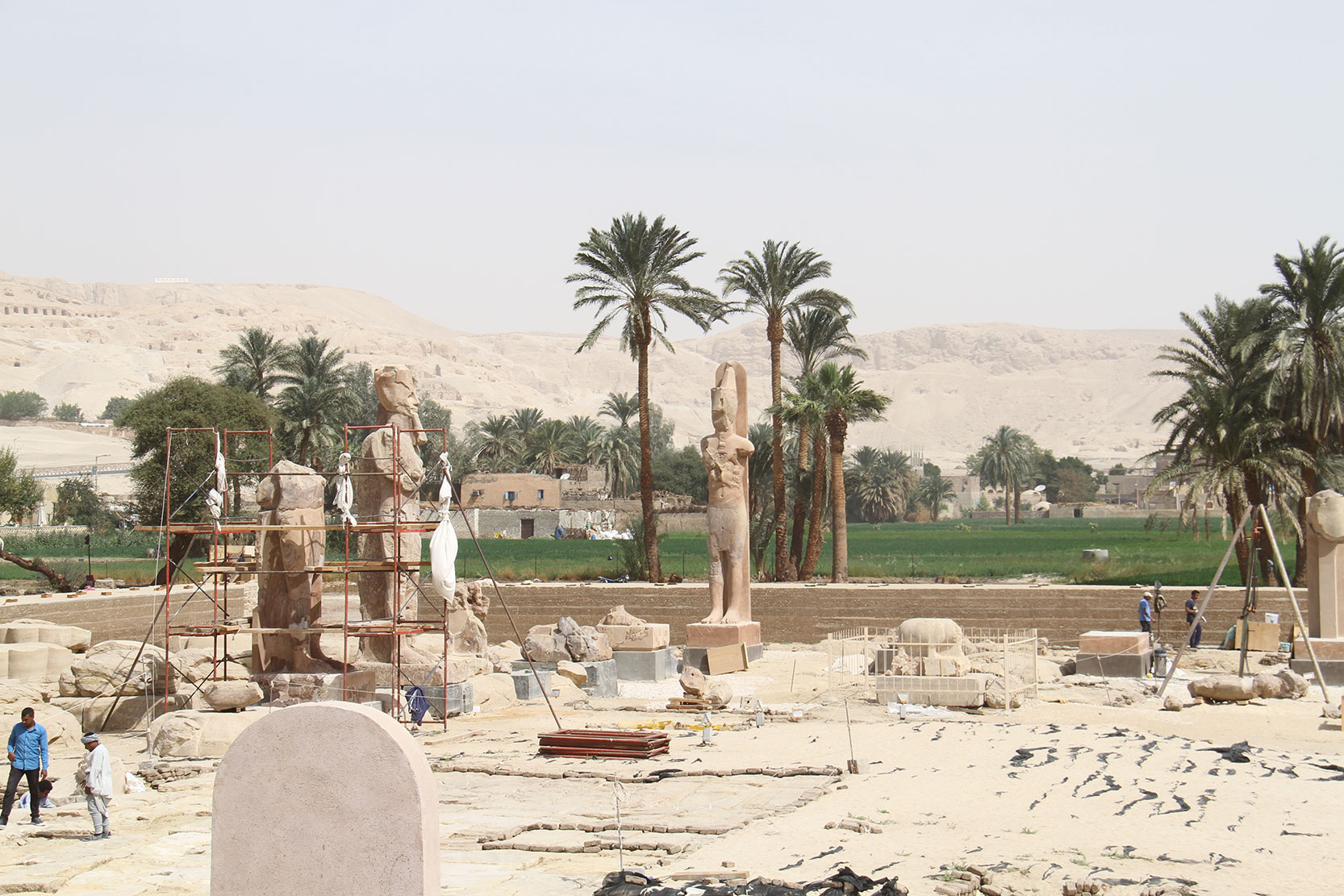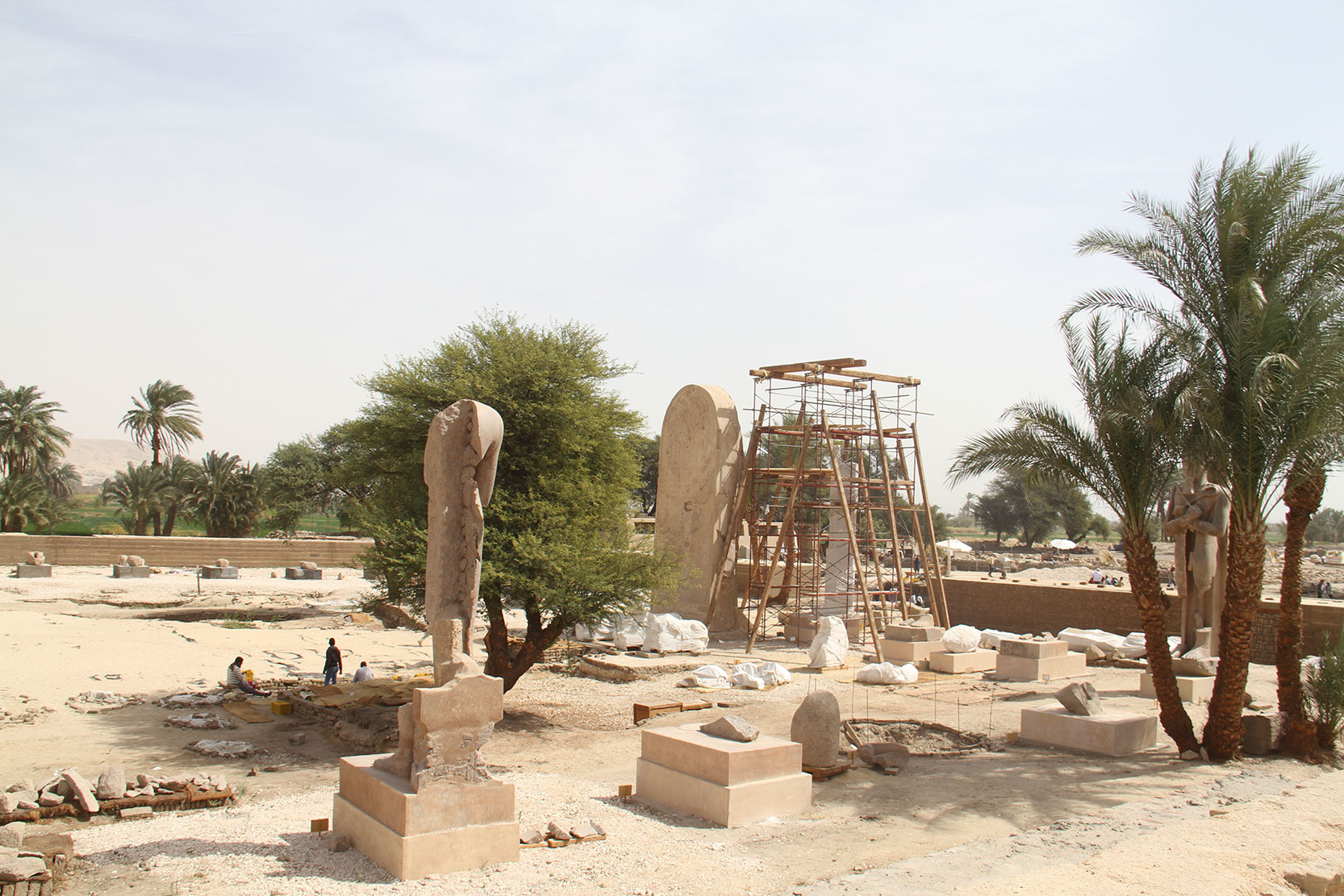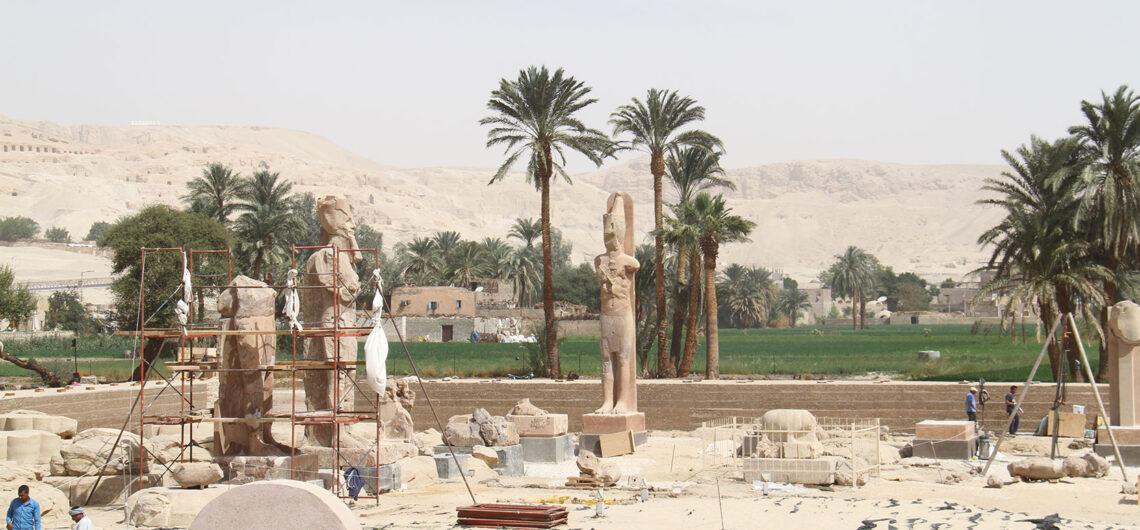Temple of Amenhotep III in Luxor Egypt | Egyptian Temples
The most important Egyptian funerary Mortuary Temples and what is the secret of its connection to the legends of The Colossi of Memnon, the history of the pharaohs and the facts of building the temple to discover the history of the Pharaonic civilization and more.
Discover the history of Pharaonic antiquities and the secrets of the most important Pharaonic funerary temples, facts about the temple of King Amenhotep III of the Eighteenth Dynasty of Egypt during The New Kingdom period, and a map of the interior design of the most beautiful open temples to tell us the secrets of Ancient Egypt civilization and more to start your cultural tourist trip to Egypt.
Temple of Amenhotep III Facts
The temple is currently in ruins and contains a few parts of the funerary temple in addition to the two statues of Memnon.
It is being restored by the Egyptian Ministry of Tourism and Antiquities, foreign missions, and Egyptology.
It is considered one of the largest funerary complexes in the city of Thebes, built during the era of the modern pharaonic state..
The facade of the temple was designed in the eastern direction so that it would be with the sunrise every morning to indicate the development of Astronomy in ancient Egypt and Ancient Egyptian science, dedicated to the worship of God Amun–God Ra, the most famous of the ancient Egyptian deities – Ancient Egyptian gods and Goddesses, the symbol of the sun in the Ancient Egyptian religion.
Funerary temples were built for the dead in ancient Egypt..
The stones of the temple were used in the construction of other Pharaonic temples in various regions of Egypt throughout the ages of Pharaonic civilization in the regions of Upper and Lower Egypt, as well as in the Geography of ancient Egypt.
Specially starting from the reign of King Ramesses I and King Seti I of the Nineteenth Dynasty of Egypt, after large parts of the temple were demolished and became dilapidated, and it tells us about the development of Architecture in ancient Egypt.
What are the reasons for the demolition of the temple of King Amenhotep III?
The continuous exposure to the annual flooding of the Nile River, which caused water to leak between the foundations and bases of the funerary temple..
The temple was hit by a major earthquake, which caused all the temple’s foundations to completely collapse..
What was the reason for building the funerary temple of Amenhotep III?
King Amenhotep III, the most famous of the Egyptian Pharaohs kings, built the temple to sanctify him as a god during his life and after his death.
The ancient Egyptians also believed that the earth was formed from a large mound rising from the water..
Where is the mortuary temple of Amenhotep III located?
It is located in Luxor on the west bank of the Nile River in front of the Funerary temple of Merenptah, built by king Merneptah, Egypt..
Who built the funerary temple of Amenhotep III?
The architect Amenhotep supervised the construction of the funerary temple of King Amenhotep III..

Map of the Mortuary Temple of Amenhotep III:
The design of the temple begins with the open outer courtyard and contains 64 columns with papyrus flower capitals.
The columns were distributed in two rows on two sides, in addition to decorations and engravings of the Pharaonic Egyptian Cartouche of King Amenhotep III on the bases and tops of the columns..
The temple contains an offering room, and the walls of the room contain engravings of the king in various scenes, offering sacrifices to the ancient Egyptian gods..
The interior architectural design included a celebration hall directly at the entrance to the temple, which contained 14 columns with papyrus flower-shaped capitals “Ancient Egyptian Papyrus“.
The column was 25 feet high, and other columns were 16 meters long. The decorations of the celebration hall were not completed..
King Amenhotep III was interested in building 32 columns in the hypostyle hall, distributed so that each row rested on 4 columns..
After finishing the hypostyle hall, you will see an altar that was built during the reign of Emperor Constantine. Texts were discovered engraved on the altar in Latin..
You will see the Holy of Holies chamber where the boat of the god Amun-Ra was placed. According to the ancient Egyptian religion, a sacred boat was brought from the Karnak Temple complex to the Holy of Holies chamber..
Funerary temple relief of Amenhotep III:
Look at the carving of King Amenhotep III on the eastern wall offering offerings and wine (Food in ancient Egypt) to the ancient Egyptian goddess Amun-Ra and the God Montu.
There is an inscription of King Amenhotep III offerings to the god Amun-Ra and the god Montu, in addition to inscriptions of the king with 4 calves, wooden boxes and fabrics..
You will see a religious inscription of the god Amun-Ra presenting the sign of life “Ankh” to King Amenhotep III..
The Greek-Macedonian Emperor Alexander the Great “Greek-Roman era” demolished 4 columns from the Holy of Holies chamber and built a shrine containing inscriptions of Emperor Alexander during the worship of the ancient Egyptian gods..
You will see a relief of King Amenhotep III worshipping the Theban Triad on the walls surrounding the chapel of Alexander the Great..

Discoveries of the Mortuary Temple of Amenhotep III:
The Egyptian government, in cooperation with foreign missions from around the world and Egyptologists, excavated Egyptian Pharaonic Egyptian Monuments around the Temple of King Amenhotep III. The following was discovered:…
- In 2010, the head of King Amenhotep III was discovered, made of red granite, the most famous of the ancient Egyptian stones and minerals “Ancient Egyptian Metallurgy“, with a length of 250 cm, in addition to 83 other artifacts, to tell us about the development of Sculpture in Ancient Egypt.
- In October 2020 AD, a 130 cm statue of King Amenhotep III was discovered..
- In November 2020 AD, a stone statue of King Amenhotep III was discovered sitting with the god Ra-Horakhty..
- In March 2016 AD, three statues of the God Sekhmet were discovered, in the form of a lion’s head and a human body..
- A statue of the king with his wife was discovered in pairs, and then an alabaster statue of Queen Tiye was discovered..
- 110 statues of the king with the god Sekhmet were discovered..
- Stone tablets were discovered at the entrance to the temple telling us about his victories and achievements, how he strengthened the army Military of ancient Egypt, unified the regions of Upper and Lower Egypt, and flourished a period in the development of Agriculture in Ancient Egypt and Industry in ancient Egypt.
The secret of building the temple near the Nile River?
The idea of building the funerary temple of King Amenhotep III near the west bank of the Nile River was the religious belief of the ancient Egyptians that the earth arose from the waters of the Nile River after the flood, as in the stories of Ancient Egyptian Literature and the legends of the pharaohs “Egyptian Mythology“.
Therefore, every year, during the flood, the Nile River floods all parts of the temple, except for the inner sanctuary, which remains visible above the Nile River waters like a hill. Then, after the flood period ends, it reappears completely again..
Over time, this caused water to seep under the foundations and construction bases of the funerary temple until it was completely demolished by the 19th Pharaonic Dynasty..
About King Amenhotep III:
Period of rule in ancient Egypt “Ancient Egyptian Government“: 1391 – 1353 BC.
Pharaonic Dynasty: Dynasty 18.
Wives:
Queen Tiye
Queen Sitamun is the most famous queen of Pharaonic Egypt “Female Pharaohs“.
Children:
Prince Thutmose
Sat Amon
Hanout Ta Nab
Packet Aton
Father: King Thutmose IV
Mother: Queen Mut-em-Wia
Date of death: 1353 BC.
Burial place: The Tomb of Amenhotep III | KV22 / WV22 in the Valley of the Kings, Luxor.
The effects:
- Palace of Malkata
- Funerary Temple in Luxor
- Temple of Amenhotep III in El Kab, Aswan.
- Memnon statues in Luxor.
Temple visiting hours:
Currently closed – the temple is under maintenance and restoration at the moment, but you can photograph the temple from the outside while driving by car on the road towards Gebel El Qurna to visit the Temple of Hatshepsut and the tombs of the Valley of the Kings.
Temple ticket prices:
Currently closed – the temple is under maintenance and restoration at the moment.
Note: Facts and secrets of the history will be added soon…
Hurghada Excursions Lovers, Best Travel Agency in Hurghada to provide daily tours to visit the Tourist attractions of Luxor by Hurghada to Luxor Tours and Hurghada to Pyramids Trips. Book online when you come to Hurghada, El Gouna, Sahl Hashish, Makadi Bay, Soma Bay, Egypt Tours Packages.
